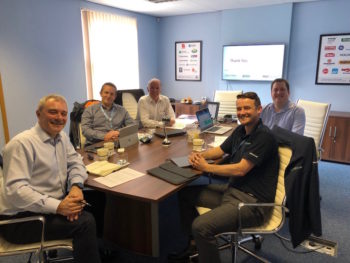Broader focus on safe sustainable mobility must take in grey fleet
Grey fleet management is becoming ever-more critical as the number of opt-out drivers rises and the industry moves to managing ‘safe, sustainable mobility’.

ACFO ‘grey fleet’ webinar speakers (clockwise from left): Simon Turner, Stewart Lightbody, John Pryor, James Pestell and Richard Evans
That was one of the key messages at a recent webinar on ‘Not so Grey: Managing Opt Out and Private Vehicles’ held by ACFO and now available for members on its website.
With around 14 million-plus privately owned vehicles driven on work-related journeys – compared to around 940,000 company cars on the UK’s roads, according to HMRC – and a rising trend of employees opting for cash in lieu of a company car, Simon Turner, campaigns director of RoadSafe, which delivers the Driving for Better Business campaign, said that the subject of who owns the car is largely irrelevant as the duty of care to manage occupational road risk is the same.
Turner added that employers are increasingly focusing on the concept of Business Mobility-as-a-Service, adding: “We’re seeing the more forward-thinking employers move away from managing occupational road risk, and they are now looking more broadly at managing safe sustainable mobility, which incorporates a much more integrated approach to where employees need to be, why they need to be there, and how businesses get them there safely.
“The mobility question is only going to become more pressing due to the rising trend in drivers taking a cash option due uncertainties over future tax liabilities and vehicle emissions.
“‘Grey fleet’ will probably form a vital part of most companies’ future mobility solutions when integrated with other travel and communication options. But it needs to be effectively managed if it is to be successful. Employers must ensure they have well thought-out policies and processes in place and stick to them.”
As such, he outlined a number of key areas of focus, including that driver licence checks were essential; driver policies should be shared with ‘grey fleet’ drivers, just as they would be with a company car driver; similar driver profiling, assessment and training regimes should be in place as with company car drivers; vehicle roadworthiness monitoring should be undertaken including checks on the status of servicing, MoT and Vehicle Excise Duty; and business insurance – highlighted as being regarded as a ‘misunderstood’ issue by drivers and company bosses – should be in place.
His comments were echoed by the rest of the speakers on the webinar including Stewart Lightbody, head of fleet services, Anglian Water and a co-opted member of the ACFO board, who said: “Fleet managers cannot absolve themselves of ‘grey fleet’ management and technology makes collating information easier.”
Anglian Water has introduced an essential user fleet allowance that enables drivers to decide how they fund their cars with the vehicle age and carbon dioxide emissions cap aligned with the company car policy.
“It is disappointing to hear that the ‘grey fleet’ issue is not being managed across the board by all organisations. At Anglian Water ownership of the asset is irrelevant. If someone is travelling on behalf of the organisation we have a duty of care and responsibility to manage accordingly,” Lightbody said.
“If you can integrate documents into a centralised system and communicate with drivers and run management information from that system fleet managers have a holistic view,” he added. “Technology must lead and it is moving at a pace. Long gone is the need for a paper trail.”
And Richard Evans, head of business development at fleet and asset management software solution provider Jaama, said technology was critical to help employers have a ‘cohesive, auditable and systemised’ approach in place to manage ‘grey fleet’ drivers and their vehicles in addition to managing company cars and their drivers.
Suggesting that ensuring the ‘grey fleet’ driver community was “on side”, Evans said: “That’s the challenge. It is really important that driving policies and risk management tools – licence checking and driver profiling – are not just rolled out to the company car community but are promoted across an organisation’s entire employee car use base. There should be no business journeys unless critical policies are in place, they have been complied with and drivers have signed up to them. Communication must come from the top of a business.
“Managers should focus on what technology can do for them and how it can automate and provide efficiencies for organisations.”
Meanwhile, James Pestell, ACFO digital secretary and national sales manager at IFC Group, which offers its Vertivia mileage capture system, warned that mileage reimbursement claims could be a ‘tax-free goldmine’ for drivers if employers failed to undertake checks.
Industry research has suggested that business mileage claims by own-car drivers could trigger an overpayment of 25%, prompting Pestell to say: “All mileage claims must go through a mileage capture system to see who is claiming and to identify ‘grey fleet’ usage.”
He claimed that 95% of companies audited by IFC Group when implementing the Vertivia mileage capture system, which also records vehicle and drive document compliance, were previously non-compliant.
As a result, he recommended that employers adopted a ‘carrot approach’ of encouraging ‘grey fleet’ drivers to submit reimbursement claims via complying with a mileage capture system rather than a ‘stick approach’ of ‘you must provide information or else’.
Backing up his comments, ACFO chairman John Pryor concluded: “It is clear that technology will help and support managers moving forward, but policy and communicating it remains king. For many businesses ‘grey fleet’ does and should provide an important part of a clear mobility policy, but managing that policy is vital.”












